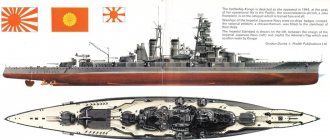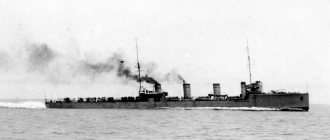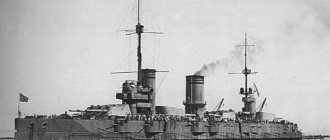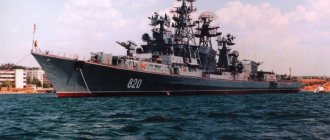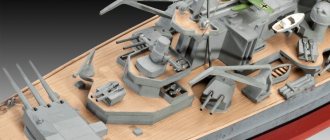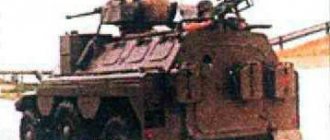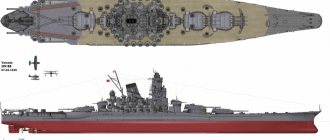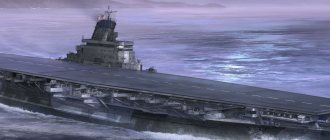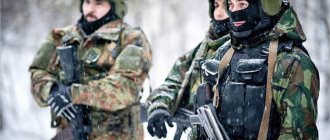Svetlana-class cruisers
After the end of the unsuccessful Russo-Japanese War, the question of what kind of fleet the Russian Empire needed was repeatedly raised in domestic military and political circles. To a large extent, this concerned not only linear forces, but also light cruisers. The rapid development of military equipment put forward new demands, and the funds and capacity of domestic enterprises were not enough. In this regard, the Russian Empire was several years behind both its Entente allies and Germany.
Due to limited financial capabilities, and ships were always expensive, a search was underway for an optimal project for the construction of eight light fast cruisers for the Baltic and Black Sea fleets. Armament became a significant problem - initially it was planned to install one or two 203 mm on the cruisers. main caliber guns in turrets and 120 mm cannons. Based on the experience of the Russian-Japanese War, they decided to abandon small-caliber artillery. But the 203-mm guns in the turrets had significant weight and required an increase in the displacement of the light cruiser. At the same time, from the experience of Bayan-class cruisers, the shortcomings of such guns were already known.
Joseph Stalin and Grigory Ordzhonikidze on the deck of a cruiser, 1929. (topwar.ru)
Time passed and finally, in 1913, it was decided to arm the light cruisers with new 130 mm guns. 130-mm cannons with a barrel length of 55 calibers had good ballistic qualities and could become a universal weapon for both light cruisers and battleships (as a mine-resistant caliber). Ultimately, each of the Svetlana-class cruisers was to carry fifteen 130 mm cannons in single-gun mounts and four 63.4 mm anti-aircraft guns.
The cost of one ship was estimated at 10 million rubles. All cruisers under construction received the names of outstanding Russian admirals of the 18th - 19th centuries. The lead ship of the Black Sea cruisers was named after Pavel Stepanovich Nakhimov. But before the First World War, not a single one of the Svetlana-class cruisers was put into operation throughout the war of 1914-1918. The Russian fleet carried out light cruisers built before the Russo-Japanese War.
Cruiser "Admiral Nakhimov": completion and renaming
In the 1920s, the USSR began to restore the fleet. In 1922, “Admiral Nakhimov” was renamed and received the name “Chervona Ukraine”. The easiest way in difficult economic conditions and in the absence of experience in building modern large ships was to complete the construction of cruisers that were in varying degrees of readiness.
How to complete it - according to the original design or with radical changes in armament? The second path was the most promising and tempting, but in a difficult situation from a technical and economic point of view, the commissioning of all 8 cruisers was impossible. Therefore, with significant changes in armament, the cruiser "Red Caucasus" was completed, receiving new 180-mm guns, and "Chervona Ukraine" and "Red Crimea" were put into operation with relatively minor differences from the original project.
General view of the cruiser "Chervona Ukraine". 1927 (war-book.ru)
In 1927, Chervona Ukraine became the first Soviet cruiser to enter service after the end of the Civil War. In the 1920s and 1930s, the ship made several long voyages, calling at ports in Turkey, Italy and Greece. And in July 1929, while sailing along the coast of the North Caucasus, I.V. Stalin was on the cruiser.
The cruiser Chervona Ukraine also played a significant role as a training ship. In 1933 - 1936, the commander of the cruiser was the future People's Commissar of the Navy N. G. Kuznetsov. In 1939, the cruiser was put in for repairs and modernization. The seaplane was removed from the ship, but the anti-aircraft weapons were strengthened: the cruiser received three installations of twin 100-mm Minizini universal guns.
TTD:Displacement: 7999 tons. Dimensions: length - 163.2 m, width - 15.7 m, draft - 5.7 m. Full speed: 29 knots. Cruising range: 3,700 miles at 14 knots. Power plant: boiler-turbine, 4-shaft, 50,000 hp. Reservations: side - 76 mm, deckhouse - 76/50 mm, deck 25 mm. Armament: 15x1 130 mm (9 deck, 6 casemate), 3x2 100 mm, 4x1 45 mm guns, 7x12.7 mm machine guns; 2x3 533 mm torpedo tubes, 2 bomb launchers, 30 depth charges, 100 anchor mines. Crew: 852 people.
Ship history:
Svetlana-class cruiser
The construction of a series of light cruisers of the Svetlana class in Russia began shortly before the First World War. In addition to the four cruisers of this type built for the Baltic in Revel and St. Petersburg, on October 19 in Nikolaev (Russud) began construction of the cruisers Admiral Nakhimov (lead) and Admiral Lazarev for the Black Sea Fleet, and on November 11, 1915 there additionally two more were laid down - "Admiral Istomin" and "Admiral Kornilov".
The main design tactical and technical elements of these future Black Sea cruisers were as follows: displacement 7600 tons, length 163.2 m, width with plating and armor 15.7 m, draft 5.58 m; power of the four-shaft steam turbine power plant is 55,000 hp. with 14 steam boilers, speed up to 29.5 knots. Reservation: main 75-mm side (from 0 to 125th frame) armor belt made of Krupp cemented steel 2.1 m high (of which 1.2 m below the waterline), above it along the entire length of the ship 25-mm Krupp belt uncemented armor. The thickness of the upper and lower decks is 20, the walls of the conning tower are 75, its roof, floor and aft beam on the 125th frame are 50 mm. Chimney casings and ammunition supply elevators were also armored. The supply of control cables was carried out through pipes with walls 50 and 75 mm thick. Armament: fifteen 55-caliber 130-mm guns on deck mounts with shields, four 63.5-mm “anti-aircraft” guns, the same number of machine guns, two underwater onboard 457-mm torpedo tubes; the upper deck could receive up to 100 mines of barrage.
The outbreak of the First World War disrupted the construction of ships. And although the first two Black Sea cruisers left the stocks on October 24, 1915 and June 8, 1916, respectively, they were never completed before the end of hostilities. Moreover, the readiness of the lead cruisers was very high. However, the increasingly deteriorating economic situation and the collapse of industry made plans for the rapid commissioning of cruisers unfeasible. Although according to the optimistic assessment given in the combat schedule of the Black Sea Fleet for 1919, approved on January 24 by the Commander-in-Chief of the Armed Forces of southern Russia, Lieutenant General A.I. Denikin, to bring the cruiser “Admiral Nakhimov” to full readiness required only two months of intensive work.
After the end of the civil war, when the question of reviving the navy arose, the fate of unfinished ships, including light cruisers, was determined. According to the head of the Maritime Academy, member of the Maritime Subcommittee for the Restoration of the Military Industry, M.A. Petrov, these ships have in no way lost their modernity. And as an example, he cited data on a new light cruiser launched in the USA in 1921 (meaning the Omaha-class cruiser), which was not much different from the Svetlana. However, the country's destroyed economy and the unpopularity of the fleet among some of its leaders had a negative impact on its revival. Of the eight ships, the government decided to commission only two light cruisers for each of the fleets. Moreover, due to financial and technical difficulties, “Svetlana” (from February 5, 1925, “Profintern”, and from October 31, 1939, “Red Crimea”) and “Admiral Nakhimov” were completed according to the original project with minor changes.
“Admiral Nakhimov” was being completed at the newly created association of Nikolaev State Plants named after. A. Marty. On December 26, 1922, the cruiser received a new name - “Chervona Ukraine”. Work on the ship was carried out extremely slowly; there was a shortage of fuel, materials, labor and various equipment. Therefore, “Chervona Ukraine” became part of the fleet only on March 21, 1927. Its first commander was N.N. Nesvitsky. The fleet commander raised his flag on it.
Accompanied by the destroyers Nezamozhnik and Petrovsky, the cruiser paid a friendly visit to Turkey in 1928. In 1930, the cruiser under the command of P.A. Evdokimov, accompanied by destroyers, made a trip to the Mediterranean Sea with a call at Messina on the island of Sicily and Piraeus in Greece, and four years later the cruiser went to Turkey again. In January 1941, after repairs, the cruiser returned to its regular place in the Northern Bay.
On June 22, 1941, he met under the command of Captain 1st Rank N.E. Basisty as part of the squadron cruiser brigade in Sevastopol. Already on June 23-25 he participated in the laying of defensive minefields. On the night of July 5, as part of a detachment of warships, he went to a new base in Novorossiysk, where he arrived at 9.00 on July 6. On August 27 at 16.19 he left for Sevastopol, where he arrived at 8.55 on August 28. On the same day at 20.45 he went to Odessa to provide fire support to our troops. August 29 - September 1 provided fire support to the troops defending near Odessa. On October 2, he went to Tendra to evacuate troops from the spit and on October 3 at 12.53 he returned with a battalion of marines.
On October 6, he left for Odessa and a day later returned back with the evacuees. On October 13 at 16.30 I left for Odessa again, where I arrived on October 14 at 7.30. On October 15, he carried out two artillery fires on enemy positions. On October 16 at 5.28, having received 1164 people, he departed for Sevastopol, where he arrived on the same day. On October 30, at 15.14, he went to Tendra to evacuate troops and at 3.00 the next day, having received them, he began moving to Sevastopol, where he arrived in the afternoon.
On November 5, Captain 2nd Rank I.A. Zaruba was appointed commander of the ship. On November 8, the first of the ships of the squadron opened fire from Sevastopol on the advancing enemy troops. On November 9 and 10, he carried out seven firings (48 and 100 shells were fired, respectively).
On November 12, 1941, a number of enemy air raids were carried out on the cruiser stationed at the Grafskaya pier (Sovtorgflotskaya pier) of Sevastopol. The first wave involved 28 dive bombers. At 11.00 the cruiser was hit by two aerial bombs in the waist area. At 12.24, three more bombs exploded in the immediate vicinity of its side. The bow of the Chervona Ukraina noticeably sank into the water, but the ship continued to fight and stay afloat. A total of 70 people died on the ship.
Air raids continued until nightfall, but no more bombs reached their target. The crew did everything possible to save the cruiser, but through two huge holes in the right and left sides, about three thousand tons of water penetrated into the interior of the ship. On the night of November 13, the list to the left side reached a critical 40°, and the commander of the Chervona Ukraina, Captain 2nd Rank N. Zaruba, by order of the headquarters of the fleet commander, gave the command to abandon the ship. At four o'clock in the morning, when the last longboat left the cruiser, it capsized and went under the water with the stern flag raised. The cruiser, which was the first to be introduced into the fleet after the October Revolution, lay at the bottom of the Southern Bay. She was the only Soviet cruiser lost during the Great Patriotic War. Its crew became part of the units defending Sevastopol, and on December 17, four coastal batteries were formed from 130-mm guns removed from the cruiser in Sevastopol.
In November 1947, the cruiser "Chervona Ukraine" was raised, docked on 02/08/1948, the hull was repaired and was used as a training station. On 10/30/1950 it was turned into a target ship. 05/10/1952 landed on the ground in the area of the Bakai Spit as a target for bombing by naval aviation.
In Sevastopol, on the Grafskaya pier, there is a memorial plaque, where the silhouette of the cruiser and the caption are carved on red granite: “Here, fighting the enemy, on November 12, 1941, the cruiser Chervona Ukraine was lost.”
This ship was commanded at different times by: - Captain 1st Rank Basisty N.E. (06/22/1941 - 11/05/1941); - Captain 2nd Rank Zaruba I.A. (05.11.1941 - 12.11.1941).
